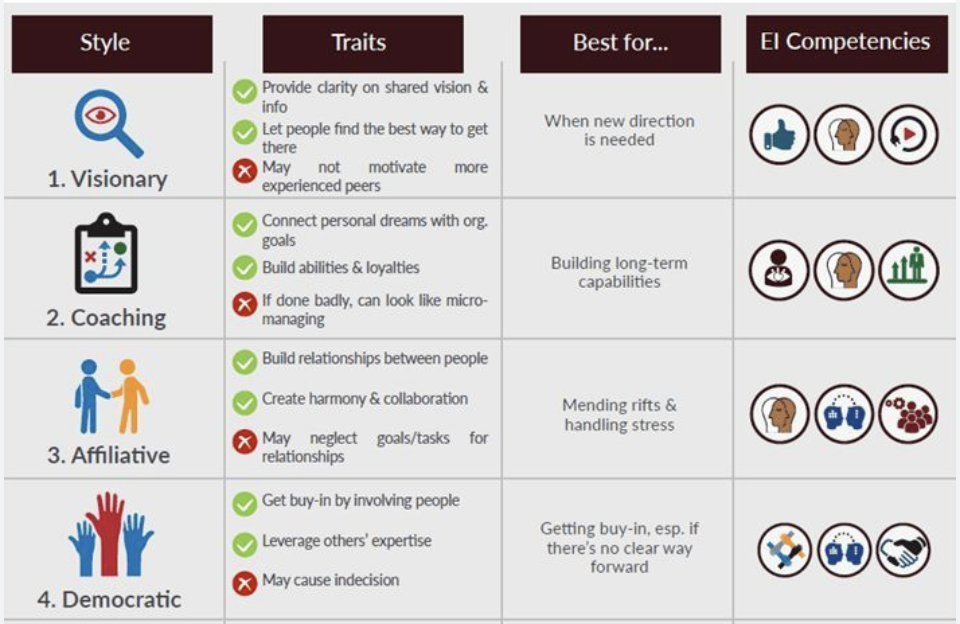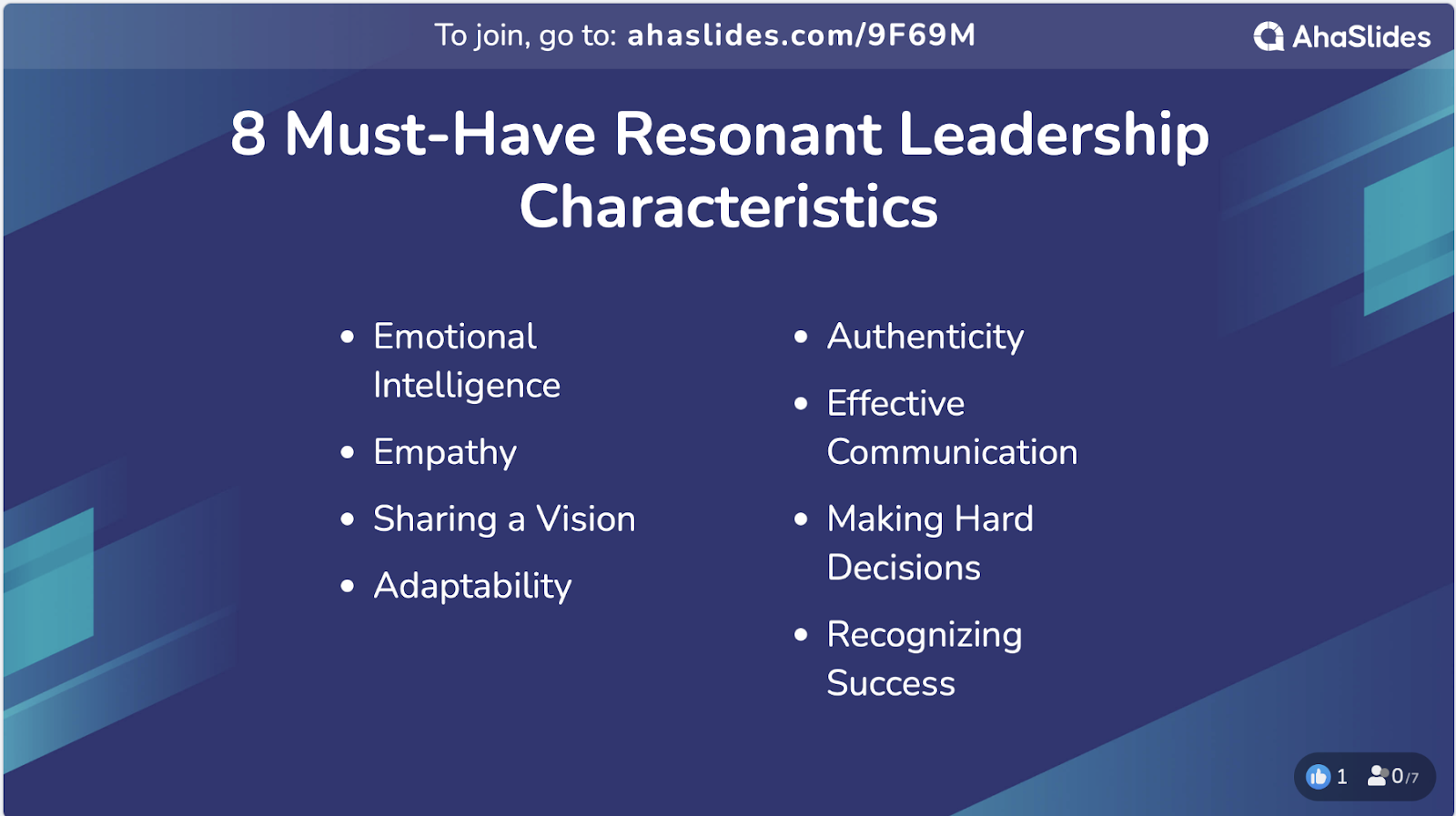How to lead a team that increases work performance while creating a positive connection between leader and team members? Many great leaders believe that resonant leadership style is the solution. Let’s see what a resonant leadership style is and how it encourages trust and credibility in the workplace.
What is Resonant Leadership Style?
Resonant leadership style refers to the effort of leaders in improving a working environment that is built based on trust and respect. When working with a resonant leader, employees feel a deep sense of connection, purpose, empowered and valued.
This leadership style is not something new, which is described from Daniel Goleman, Richard Boyatzis, and Annie McKee in their book “Primal Leadership: Realising the Power of Emotional Intelligence.” It explores the role of emotional intelligence in leadership and introduces the idea of resonant leadership as a powerful and effective leadership style.

What is The Power of Resonant Leadership?
The importance of resonant connection at work couldn’t be ignored. There are several reason why resonant leadership style is common nowadays:
- Employees feel empowered and valued. Team members are motivated to express their ideas, take risks, and collaborate effectively.
- They feel supportive, each individual is supported and guided to overcome challenges and achieve their full potential.
- It is less stressful in working with resonant leaders because it is a priority for these leaders to take care of employee well-being.
4 Resonant Leadership Examples
There are four main types of resonant leadership style including visionary, coaching, affiliative, and democratic, which are extensively discussed below with definitions and examples.

Source: “Primal Leadership: Realising the Power of Emotional Intelligence.” by Daniel Goleman, Richard Boyatzis, and Annie McKee.
Visionary
- Definition: Visionary leaders inspire and motivate by creating a compelling vision of the future. They articulate a clear and inspiring picture of where the organisation is headed, instilling a sense of purpose and direction among their team members.
- Example: A CEO, like Elon Musk is known for his visionary leadership. He paints a futuristic and ambitious vision for the companies he leads. He communicates a long-term vision for the company, outlining goals and objectives that resonate with employees.
Coaching
- Definition: Coaching leaders focus on the personal and professional development of their team members. They provide guidance, constructive feedback, and support to help individuals grow and achieve their full potential.
- Example: Bill Gates has been recognized for his coaching leadership style. As a mentor to many in the tech industry, Gates has provided guidance and support to individuals seeking to grow in their careers. He leads by investing time in the growth and success of each employee in the company.
Affiliative
- Definition: Affiliative leaders prioritise building strong relationships and fostering a positive work environment. They value collaboration, teamwork, and the well-being of their team members. In times of conflict, they work to reconcile differences and promote harmony.
- Example: A team leader who places a high emphasis on creating a supportive and inclusive team culture shows affiliative leadership. Richard Branson (Founder of the Virgin Group) is an excellent example. He encourages open communication, promotes a friendly and collaborative culture within the Virgin Group, emphasises the well-being of employees and the creation of a supportive work environment.
Democratic
- Definition: Democratic leaders involve their team members in decision-making processes. They value input from the group, encourage participation, and seek consensus. This approach fosters a sense of ownership and empowerment among team members.
- Example: Indra Nooyi is often cited as an example of democratic leadership. She engaged her leadership team and sought input from employees at various levels by encouraging managers to hold regular team meetings to discuss project strategies, challenges, and potential solutions. Nooyi encouraged open communication and inclusivity, involving different perspectives in decision-making processes.
8 Resonant Leadership Characteristics
What are the 8 characteristics of a resonant leadership? This part will answer your questions which help you build a foundation for effective leadership.

Emotional Intelligence
A must-have of successful resonant leadership is high emotional intelligence, which includes self-awareness, self-regulation, social awareness, and relationship management. They are attuned to their own emotions and the emotions of others, allowing them to navigate interpersonal dynamics effectively.
Empathy
Resonant leaders demonstrate empathy by understanding and sharing the feelings of their team members. They consider the perspectives of others, creating a sense of connection and fostering a supportive work environment.
Sharing a Vision
Having a clear and inspiring vision for the future is what a resonant leader should have. It is about communicating their vision to their teams, providing a sense of purpose and direction. This visionary outlook motivates and aligns team members toward common goals.
Adaptability
The resonant leadership style promotes adaptable and flexible management approaches. Leaders should adjust their style based on the needs of the situation and the individuals involved. This adaptability contributes to effective leadership in diverse circumstances.
Authenticity
Resonant leaders are authentic and genuine in their interactions. They bring their true selves to the workplace, creating an environment where openness and authenticity are valued. This authenticity fosters trust and transparency within the team.
Effective Communication
It cannot lack effective communication ensuring that their messages are clear, transparent, and inspiring. Leaders in this style of leadership use communication as a tool to build understanding, alignment, and a shared sense of purpose within their team.
Making Hard Decisions
Like many leadership styles, resonant leaders have the ability to make tough decisions when necessary. They approach challenging situations with courage and a focus on the overall well-being of the team and organisation.
Recognizing Success
It is important for a resonant leader to actively recognize and celebrate the successes of their team members. It is their role to understand the importance of acknowledgment and appreciation in fostering a positive and motivated work environment.
Differences between Resonant and Dissonant Leadership Styles
If resonant leadership style is employee-centric, dissonant is conversely, it focuses on result-oriented. It is conservative topic when talking about effective leadership should concentrate on the achievement of goals and outcomes rather than prioritising the well-being and emotions of team members.
It’s important to note that the effectiveness of leadership styles can vary based on the nature of the organisation, the industry, and the preferences of the team. In certain situations, a more results-oriented approach may be necessary, especially in highly competitive or rapidly changing environments. However, a purely dissonant leadership style can sometimes neglect the long-term impact on team dynamics, employee turnover, and overall organisational culture, which are expressed in resonant leadership style.
Key Takeaways
Leadership effectiveness often involves finding a balance between achieving results and maintaining a positive and supportive workplace. Some successful leaders adopt a hybrid approach, combining elements of resonant and dissonant leadership styles based on the context and the needs of the organisation, striving for a dynamic and adaptive leadership style.
Frequently Asked Questions
What are examples of resonance?
Some good examples of resonant behaviour can include individuals responding positively to emotional cues, being attuned to the emotions of others, and fostering a sense of harmony and connection. In the workplace, resonant behaviour is a key aspect of resonant leadership, where leaders create a harmonious and supportive environment.
What is an example of resonant leadership?
An example of resonant leadership is a manager who communicates a compelling vision for the future (visionary leadership) but also actively engages with team members on a personal level. They are willing to provide coaching and support for individual growth, foster positive relationships within the team, and involve team members in decision-making processes (coaching, affiliative, and democratic leadership).
Which leadership style is the best?
There is no exact answer for this question as whether a leadership style is effective or not is based on many factors, such as organisation’s culture, the nature of the tasks at hand, and the characteristics of the team. Each leadership style has both pros and cons and work best for specific situation. And it is the role of managers or leaders to find out the leadership style that is best fit for the team and the organisation.




